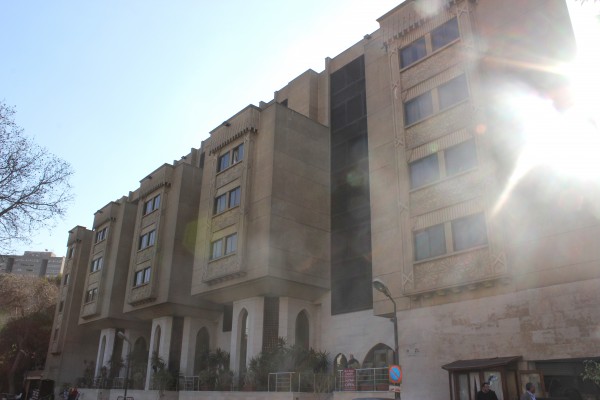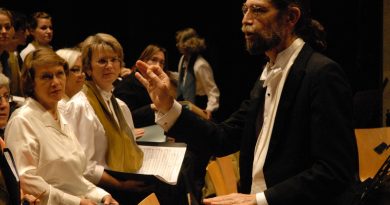The Roaring Lions of Cairo Take on AUC Arts Center
Musical ensemble Lions of Cairo band blended both European and Arabic music from the Medieval and Byzantine eras when they performed at the Arts Center Hall on October 31.
The Arts Department organized the concert “The Black of Cairo” primarily to highlight the meeting of cultures through the amalgamation of European and Arabic music.
Formed by Professor and Director of the music program at AUC, John Baboukis, the Lions of Cairo – which includes Virginie Foucard, and alumna Nesma Mahgoub – regularly performs a variety of music, including Western medieval and Renaissance, Byzantine chant, English Lute, and Classical composition.
Foucard is a soprano and actress who performed as soloist, choir member, and actress in several stage productions in France, including an adaptation of North West Theater’s 2015 stage play, Esther, as a member of the choir.
Mahgoub is an AUC graduate who studied journalism, theater, and music, and is known as the eighth season winner of the talent show Star Academy in 2011.
After an introduction by the group’s leader Baboukis, the audience was introduced to fragments of music pieces from different eras and cultures that had a symbiotic similarity to one another.
The trio were later accompanied by composers Alaa Saber on oud, Hany El Sawaaf for riq, and Chelsea Green on guitar during the latter half of the performance.
The group performed several pieces for an hour, starting with Medieval Polish sacred music, consisting of religious compositions in Latin, including the composer Elzear Genet’s Recoradre Domine and artist Krzysztof Duda’s Cristicolis Secunditas.
“The reason we incorporate different music genres like Arabic and Renaissance Western music is that Eastern and Western music were much more alike in the medieval period than today. Our goal with this group is to show people these connections,” said Baboukis.
The main connection between those fields is the fact that European folk music influenced early Classical Arabic music and non-religious European music.
Aspects of European music that were used to compose Arabic music include middle age troubadour music and Italian Lauda, a form of vernacular sacred song that was present in Medieval and Renaissance in Italy.
The performance was well organized and timed. First, it started with performances in a similar vein as acapella. Without music, the sopranos managed to convey a semblance of music with only their voices, the same feeling one gets in church.
The pieces were brief but memorable, forming images that transformed the hall into a spiritual space.
The first part of the event, the chant, was so impactful that it was disappointing when the instruments came in, despite how solid the composers’ performances were.
“I was just passing by when I heard the Polish chant and I found myself sitting amongst the audience, mesmerized,” said Engineering Alum Ahmed Shawky.
The group transitioned to Byzantine chant, the sacred chant of Orthodox churches in Eastern Rome that was a composite of classical and Jewish music.
Baboukis gave a solo performance for The Choir of the Holy Fathers, which tells the story of priests gathering at the ends of the Earth and committing to the teachings of the Father, the Son, and the Holy Spirit.
The group then moved to The English Lute Song, a form of music in the late Renaissance and early Baroque eras in which a singer performed with a lute and at times used a bass viol to support the bass line in a performance.
“I love how the show included a variety of genres yet it never felt dissonant. The transition and even similar notes between the music pieces really surprised me,” added Shawky.
The group used a synthesized piano to match the sound of a typical Renaissance lute as close as it could, with Chelsea Green as the Guitarist to replace the bass.
Among the works the groups played were, John Dowland’s Come Again, Sweet Love, and Enriquez de Vadacrrabano’s Sonnet, which were love songs of the 15th century.
“Basically, sonnets were the rock music of the time,” joked Baboukis.
The group’s final transition was in the form of Classical Arabic music, which used instruments that were already implemented in Europe, including the Lute, Rebec, and Nakkara.
They finished off with performances based on Riad Al Sunbati’s Lunga Farah-fazah and Mohamed El Qasabgi’s Zekrayati.
Baboukis reflected on why he believes this ensemble matters and what future awaits his group.
“There is no other ensemble in Cairo that I know that presents the synergy between these various pieces of music, and I think The Lions will thrive as long as I have the energy to maintain and develop the work to do,” he said.




